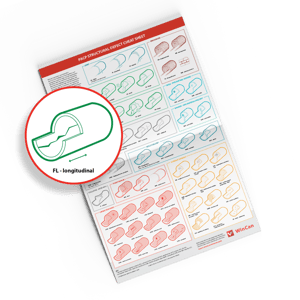 Before the development of defect coding catalogs, a big issue facing sewer maintenance supervisors was consistent data. How could they take qualitative observations and turn it into measurable, actionable information? Many cities created their own defect catalogs, while others chose to tweak catalogs from other countries to fit. After the National Association of Sewer Service Companies (NASSCO) released their Pipeline Assessment and Certification Program (PACP) to the U.S., cities were able to drop their custom defect catalogs for an out-of-the-box catalog. Using the codes and ratings from PACP allows camera operators to log observations cleanly and consistently from pipe to pipe, inspection to inspection over time. Supervisors and engineers can compare defects from different parts of their system, inspected by different operators on different days, using their computers to analyze and prioritize repairs.
Before the development of defect coding catalogs, a big issue facing sewer maintenance supervisors was consistent data. How could they take qualitative observations and turn it into measurable, actionable information? Many cities created their own defect catalogs, while others chose to tweak catalogs from other countries to fit. After the National Association of Sewer Service Companies (NASSCO) released their Pipeline Assessment and Certification Program (PACP) to the U.S., cities were able to drop their custom defect catalogs for an out-of-the-box catalog. Using the codes and ratings from PACP allows camera operators to log observations cleanly and consistently from pipe to pipe, inspection to inspection over time. Supervisors and engineers can compare defects from different parts of their system, inspected by different operators on different days, using their computers to analyze and prioritize repairs.
PACP is an excellent system; however, its level of detail imposes a learning curve for users. With so many codes and requirements to ensure correct, consistent data, gaining familiarity takes time. For new users, this involves cross-referencing observations to a thick binder of descriptions and example photos.
Many defects can appear similar in the line, but must be coded differently and may make a significant difference in how the issue is repaired. One example is hole codes (HSV or HVV) versus the surface damage missing wall code (SMW). In both cases they indicate missing pipe material, but each denotes a different cause and requires a different solution. A hole is made by a severe break or fracture caused by structural forces and should be repaired in a way that restores the structural integrity of the pipe and prevents future fractures. SMW is a result of corrosion degrading a pipe to the point that a hole forms. As such, the line must be repaired using a method that restores lost pipeline material while protecting the line from further corrosion.
Keep defect codes straight — every time — with our new Code Reference: PACP Structural Defects poster, which provides clear illustrations of each defect with their corresponding code and notes important details. Post it up in your office or inspection truck for easy reference. Request your copy here:





